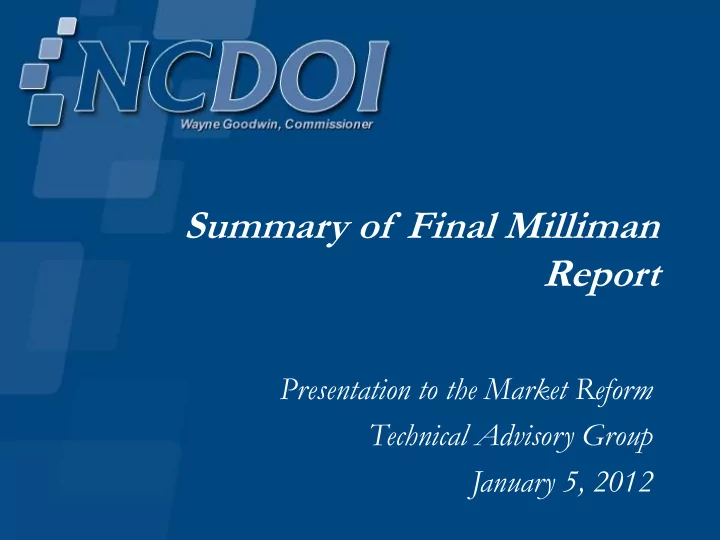

Summary of Final Milliman Report Presentation to the Market Reform Technical Advisory Group January 5, 2012
NCDOI Contracted with Milliman to Analyze HBE Design Questions • Scope of work included: – Health insurance market analysis, including impact of ACA reforms on enrollments and premiums – Modeling impact of merging individual and small group health insurance markets – Modeling impact of allowing groups of 51 – 100 employees to participate in the Exchange beginning in 2014 – Strategies for mitigating adverse selection – Cost to state of continuing currently mandated benefits – Potential budget and staffing plan for 2014 and 2015 – Use of standardized benefit plans – Basic Health Plan analysis – Consideration of other HBE design issues
Market Analysis – Enrollment Projections • 663,000 individual market HBE enrollees in 2014, increasing to 856,000 in 2016 • 51,000 small group market HBE enrollees in 2014, increasing to 58,000 in 2016 (includes groups of 51 – 100 in 2016) • Medicaid/CHIP enrollment increases from 1.4 million in 2013 to 1.9 million in 2014 • Number of non-elderly uninsured drops from 1.5 million (18%) in 2013 to 700,000 (8%) in 2014
Estimated Pre-65 Health Insurance Enrollment Distributions
Expected Demographics of HBE Enrollees (Individual Market) • HBE enrollees are expected to be older than non-HBE enrollees (average age of 35.8 vs. 29.9) • HBE enrollees are expected to have lower incomes than non-HBE enrollees – 29% of HBE enrollees expected to have incomes below 200% FPL, vs. 12% of non-HBE enrollees – 75% of HBE enrollees expected to have incomes below 400% FPL, vs. 37% of non-HBE enrollees • HBE enrollees are expected to have higher average health risk than non-HBE enrollees (roughly 12% more expensive after adjusting for age differences)
Merging Small Group and Individual Markets • Milliman estimated that the average health risk of individual market enrollees will be worse than that of small group enrollees in 2014 • Merging the two markets would have an adverse effect on small group rates on average • Milliman recommended that NC seek input from carriers on this issue
Allowing Groups with 51 – 100 Employees to Participate in Exchange • ACA requires that groups of 51 – 100 be allowed to participate in the HBE starting 1/1/2016, but states have the option to include them beginning in 2014 • Milliman projected similar average health risks for groups of 1 - 50 and groups of 51 – 100 – To be consistent with insurance market outside the HBE, NC would need to redefine small group to include groups of 51 – 100 – Impact for specific groups of 51 – 100 moving from experience rating to adjusted community rating could be significant
Ways to Mitigate Adverse Selection (health risk is not spread evenly across plans/carriers/markets) Mechanisms in ACA Potential State Options • Risk adjustment, reinsurance, risk • Require all health insurance be sold only corridors in HBE • Single risk pool for insurers’ business in • Require all carriers participate in HBE • Require all carriers offer all benefit levels and out of HBE for each market • Similar benefit rules inside and outside • Place restrictions on plans offered HBE outside HBE • Premium and cost sharing subsidies • Ensure consistency of marketing and • Individual mandate pricing rules in and out of HBE • Take steps to maximize HBE enrollment • Restrict HBE enrollment times
Analysis of Mandated Benefits • ACA requires states to cover the cost of any mandated benefits not included in the Essential Benefits package for ALL HBE enrollees • Milliman estimates the cost to the state to be $39 million in 2014, increasing to $59 in 2015 • Estimates can be further refined once the Essential Benefit package is defined by the US HHS
Projected HBE Administrative Expenses Baseline Reform Scenario for 2015 Projected HBE Administrative Expenses $25 million Across HBE Members Only - Per member per year $31.50 - Percent of premium 0.41% Across all Individual and Small Group Commercial Fully-Insureds (in & out of HBE) - Per member per year $14.70 - Percent of premium 0.20% Across all Commercial Fully-Insureds (in and out of HBE) - Per member per year $9.38 - Percent of premium 0.13% Across all Commercial Fully-Insureds and Self-Funded - Per member per year $4.64 - Percent of premium 0.06%
Standardized Benefit Packages Pros Cons • Simplifies comparison for consumers • Reduces product choice for consumers • Encourages competition on price and purchasing through the HBE • Stifles innovation in HBE quality rather than benefit design • May reduce administrative burden and • May slow introduction of benefit cost of HBE innovations
Establishing a Basic Health Plan (BHP) • ACA provides states the option of creating a BHP for individuals with incomes under 200% FPL who are not eligible for Medicaid or other affordable coverage option • State must contract with managed care organization • Individuals must get better benefits at lower cost than through HBE • State is provided 95% of federal subsidy amount individuals would have received through HBE coverage to fund BHP
Establishing a Basic Health Plan (BHP) Pros Cons • Could offer more affordable coverage to • State would bear pricing risk • Reduces HBE enrollment by estimated lower income enrollees • Could ease transition between Medicaid 142,000 in 2014 • Creates administrative burden for state and private coverage • Reduces choice for low income
Other Topics Covered • Agent/broker compensation and roles • Interstate exchange • Intrastate exchanges • Mandatory insurer participation in HBE • HBE as market organizer or active purchaser • HBE role in engaging consumers, improving quality and efficiencies, and increasing competition
Questions?
Recommend
More recommend